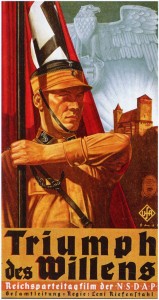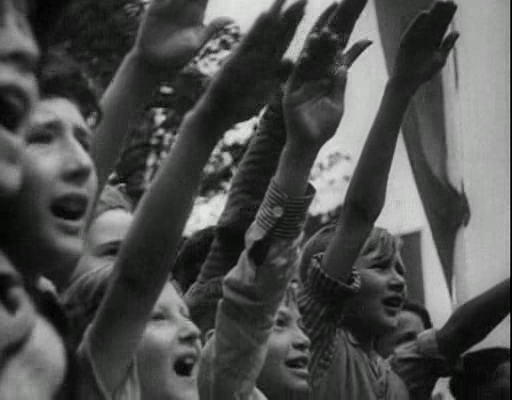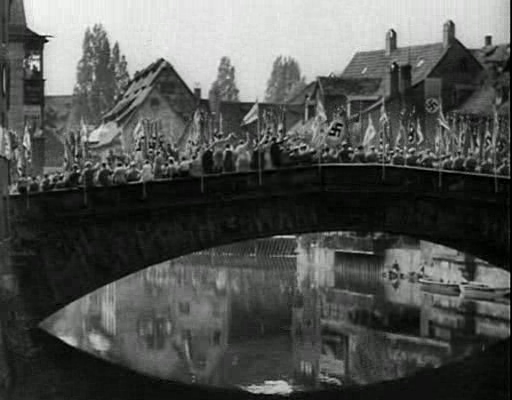Triumph of the Will (1935)
“It is our will that this state shall endure for a thousand years. We are happy to know that the future is ours entirely!”
|
Synopsis: |
|
Genres, Themes, Actors, and Directors:
Response to Peary’s Review: In his review, Peary provides a useful overview of Riefenstahl’s many “expert” techniques in projecting “a positive image” of Hitler — including her “employment of symbols”, “camera movement (to keep potentially dry material from seeming static), camera placement (Hitler is always shot from below to make him seem heroic), and thematic use of light and darkness”. All of this is true — and yet Roger Ebert provides a slightly different perspective in his “Great Movies” review, where he argues that it’s actually “a terrible film, paralyzingly dull, simpleminded, overlong and not even ‘manipulative’, because it is too clumsy to manipulate anyone but a true believer.” However, Ebert’s perspective on the film seems to come from a modern viewing stance, rather than acknowledging its impact on those who were watching it at the time; while I’ll concede that I found it boring to sit through the entire two-hour film, I’m not its target audience — i.e., a German citizen in the 1930s wondering about the fate of my country. As Peary notes, the “film made [Aryan] Germans feel comfort about their future”, and to that end, Riefenstahl most definitely “succeeded” in her disturbing goals. In sum, though it’s tempting to “boycott [the film] strictly because of its ideology”, it’s worth sitting through once — though “ironically, you’ve probably seen most of the footage already”. Redeeming Qualities and Moments: Must See? Categories
(Listed in 1001 Movies You Must See Before You Die) Links: |




One thought on “Triumph of the Will (1935)”
A once-must…only because you can’t say you haven’t seen it. That’s just not allowed because it’s too important an historical document.
I hope to never see it again. I’d only seen it once before. In college. I recall there was a screening of it, though I don’t believe it was for a class – it was an open screening in an auditorium but our school wasn’t particularly known for open screenings of films.
As Marlene Dietrich’s character in ‘Judgment at Nuremberg’ tells us, many Germans did not know what was really going on during this time. Riefenstahl herself claimed to be such a person. I’m not saying I don’t believe those people when they say that. But, watching this film…it’s difficult to comprehend that people could have been so squashed in their own lives that they would grab hold of the mixed message Hitler was offering up for their safety and ultimate freedom. As Hitler says in the film, “…you must be peace-loving and courageous at the same time.” “Peace-loving” for whom? “Courageous” in what way? Nothing said in this film is particularly clear…and yet nothing really damns the various speakers. Although things do slip out. Early on, one speaker informs the ever-present CROWDS of listeners, “A people which does not hold with the purity of its race will perish!” …Ah, there we have it: “the purity of its race”. In other words, “You are either us or you are not us.”
To a degree, Riefenstahl can be believed when she says that her focus was on making a good film, regardless of the politics. To a large extent, she has succeeded in making an arresting-looking film. She has a great eye and she knows how to give a film its own kind of ‘tension’…as a collection of imagery. She also gives Hitler quite an entrance…in a way almost worthy of Garbo. …Or perhaps Joan Crawford. Early on, Riefenstahl sets an intriguing mood for the film by creating a welcoming travelogue of the German landscape and its people, captured as just being plain, hard-working, almost fun-loving folk.
But that gives way to intense boredom as the film progresses. Be prepared: you will be listening to a lot of meaningless claptrap spewed forth by various Party members.
And the last 15 minutes is, by far, the worst of it: the final meeting of the sixth Party Congress…a bizarrely monumental gathering – which Hitler calls “a great spiritual meeting” but is scary in its scope alone. It becomes alarming as Hitler blathers on and on, seemingly to encourage and inspire his followers. Seemingly; as mixed messages tend to work. (By the way, one has only to listen to Hitler’s final speech here to see where Kander and Ebb got the inspiration for the chilling ‘Cabaret’ number ‘Tomorrow Belongs To Me’.)
Note: FFs really should not see this film and then leave it as an isolated document. It’s strongly recommended that they also see the 1993 documentary ‘The Wonderful, Horrible Life of Leni Riefenstahl’ as a companion piece of sorts. It really is valuable in a number of ways as a follow-up.